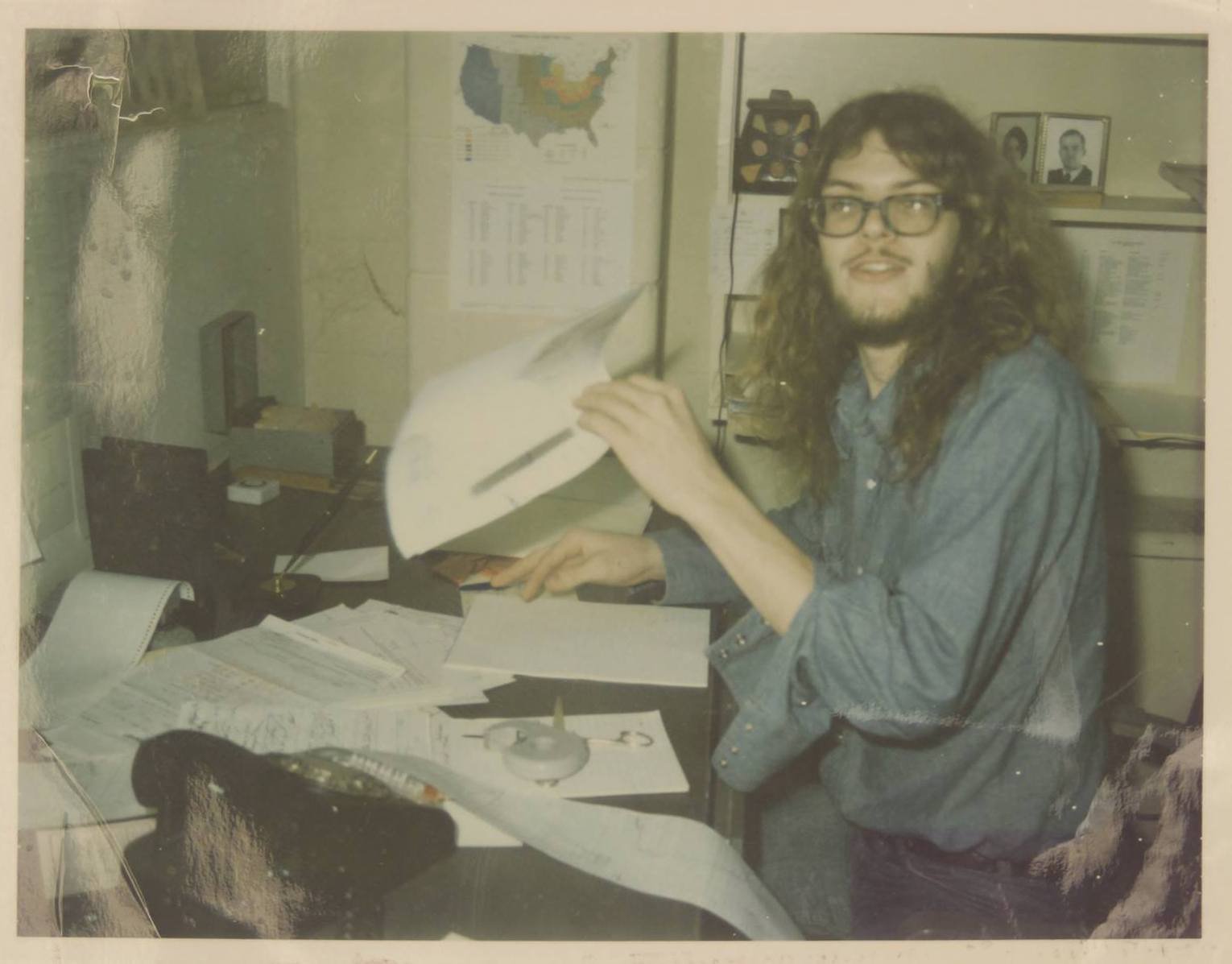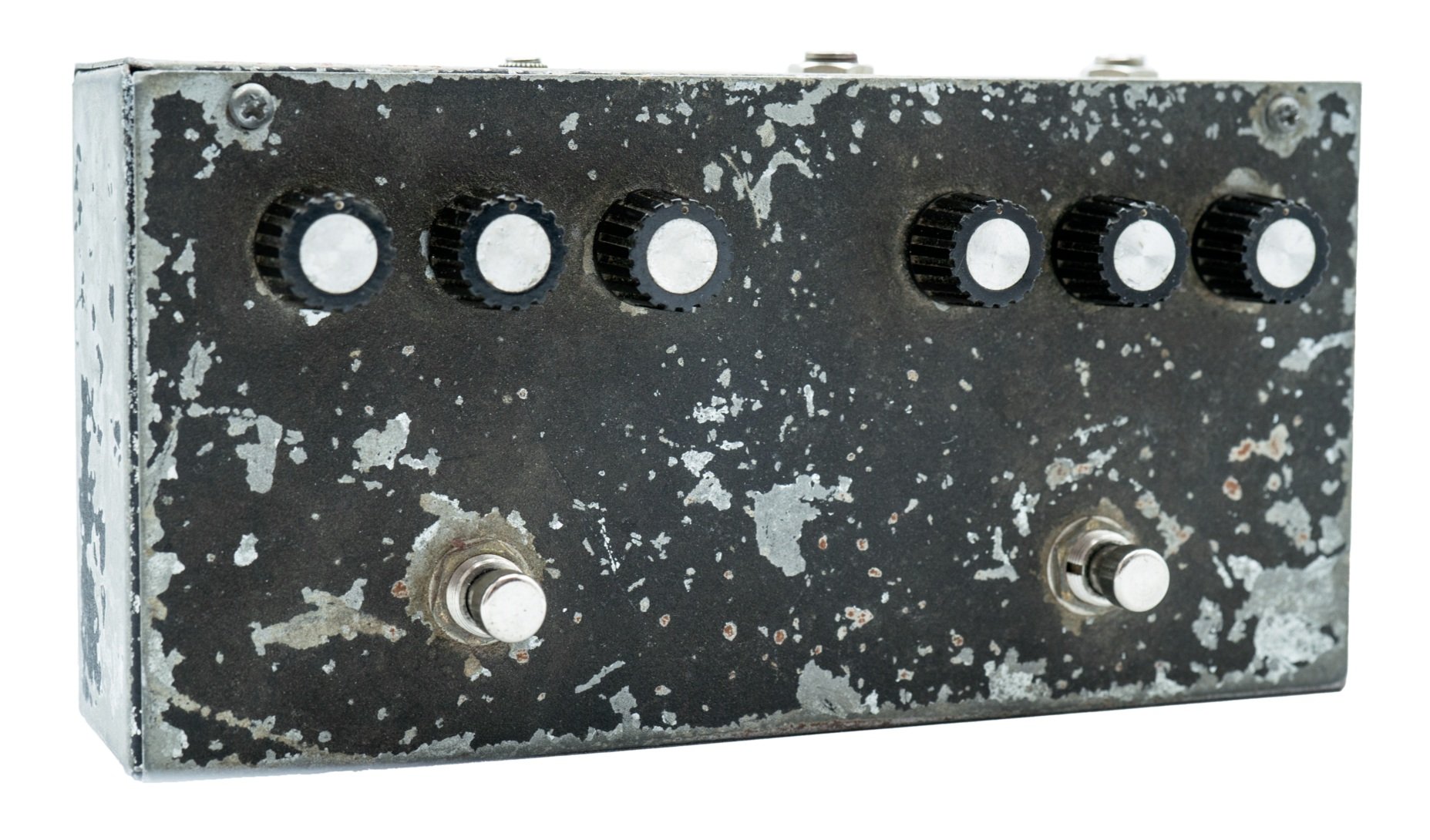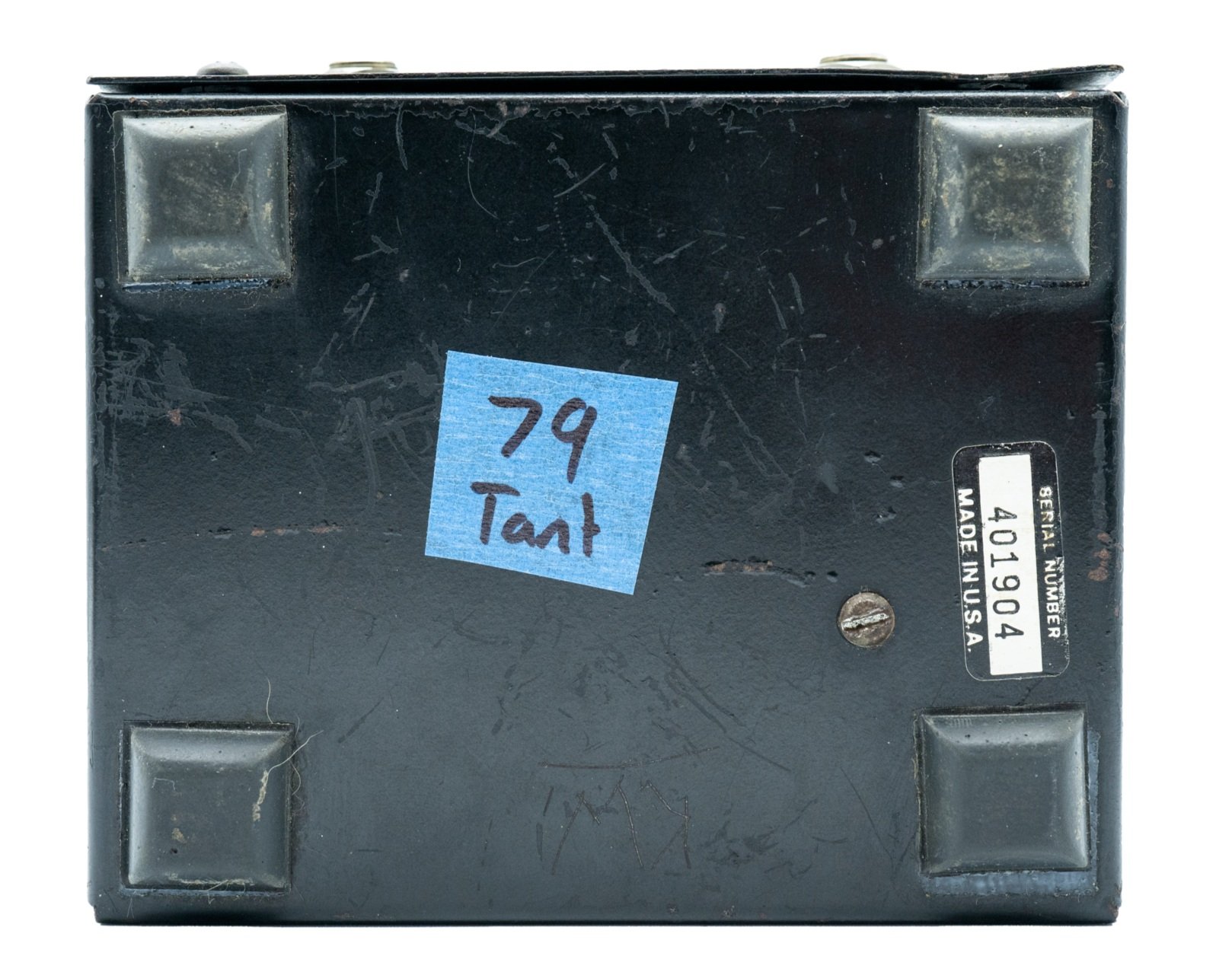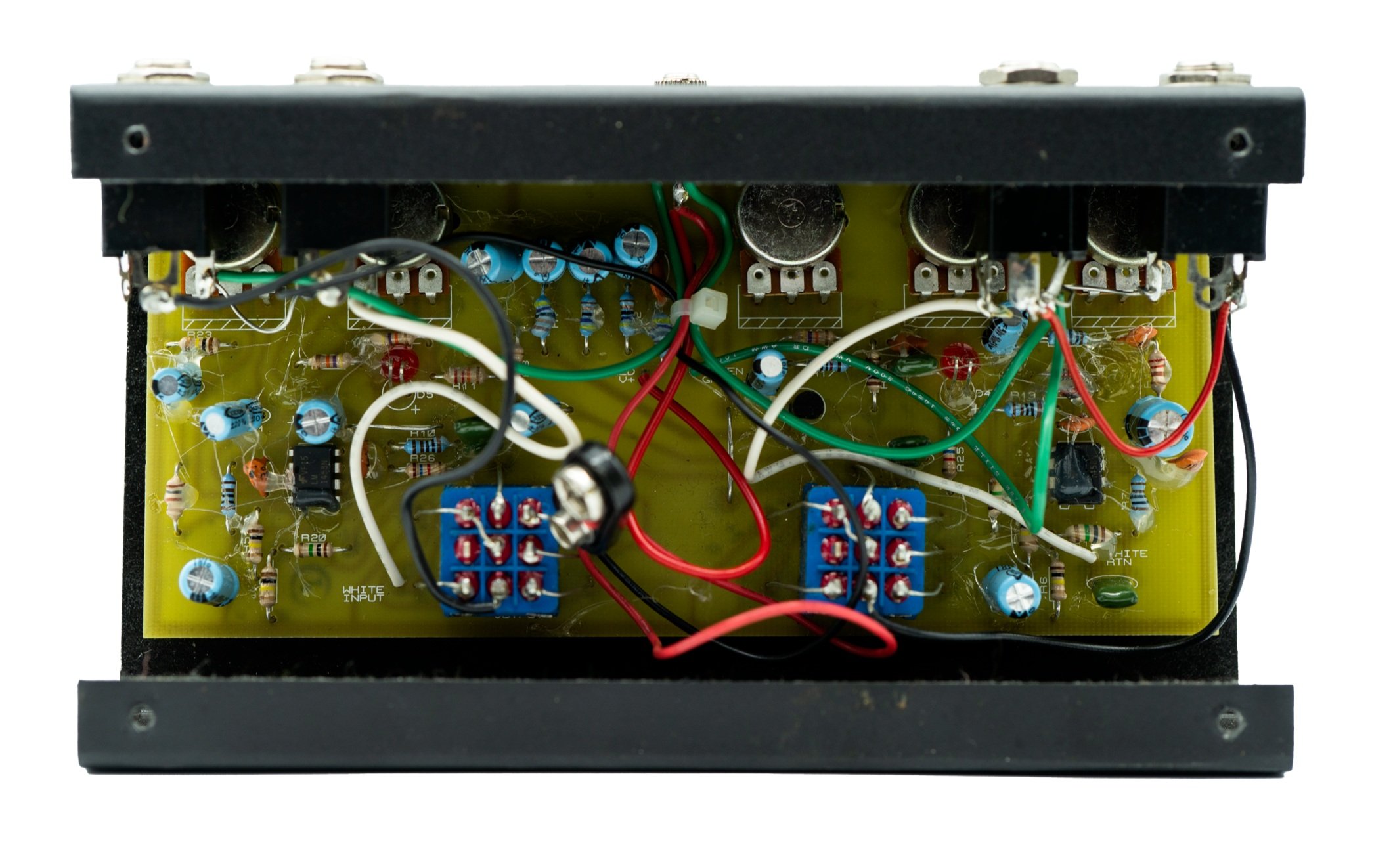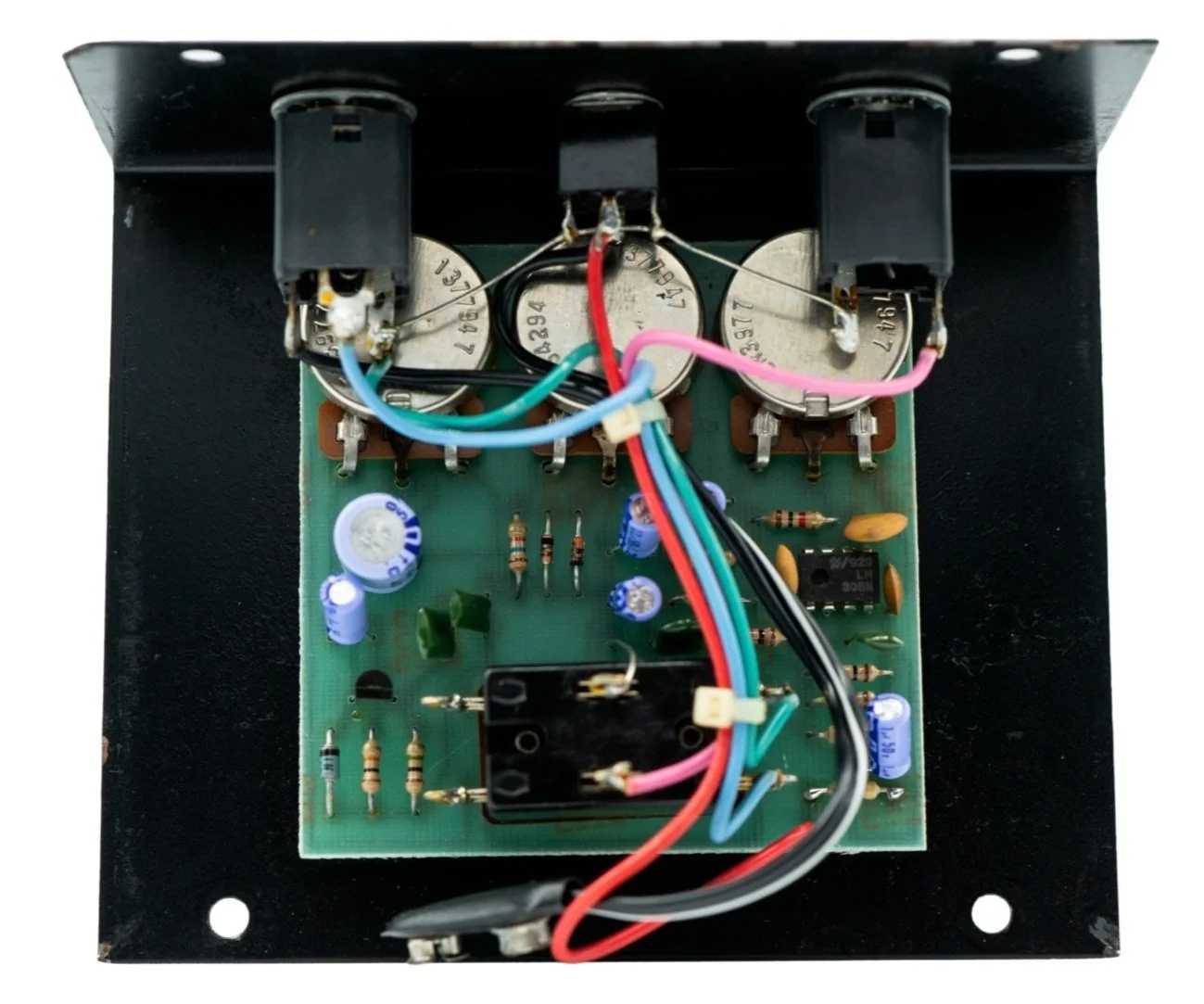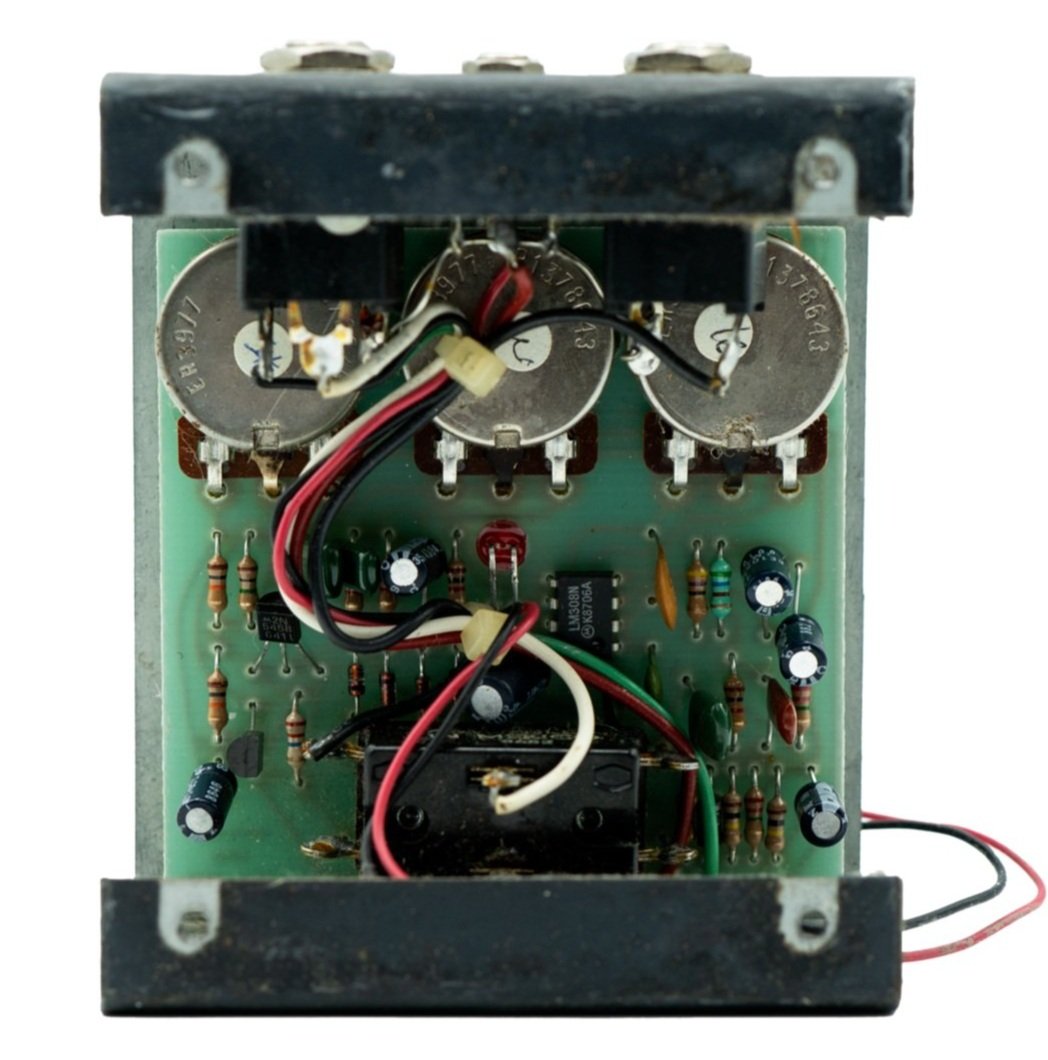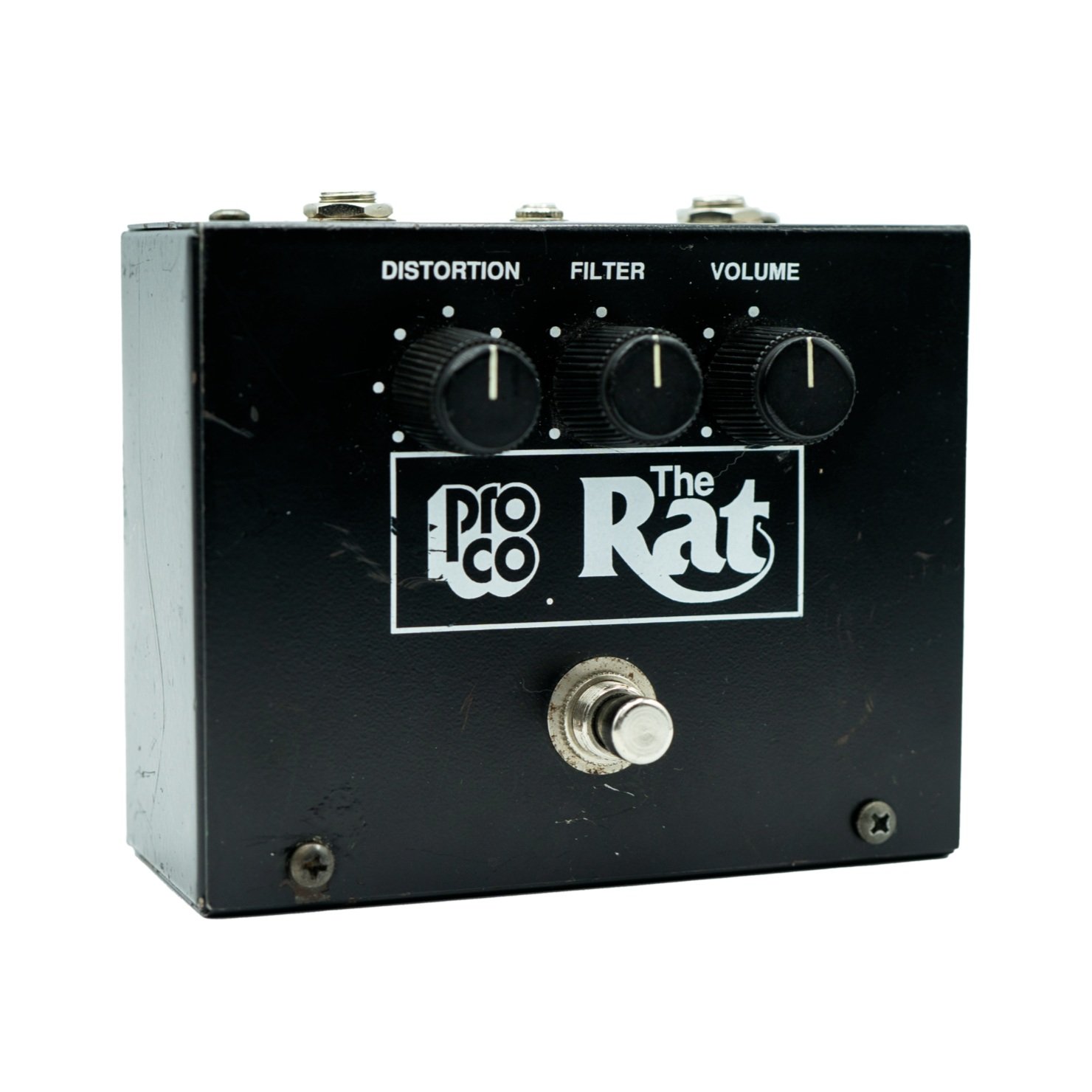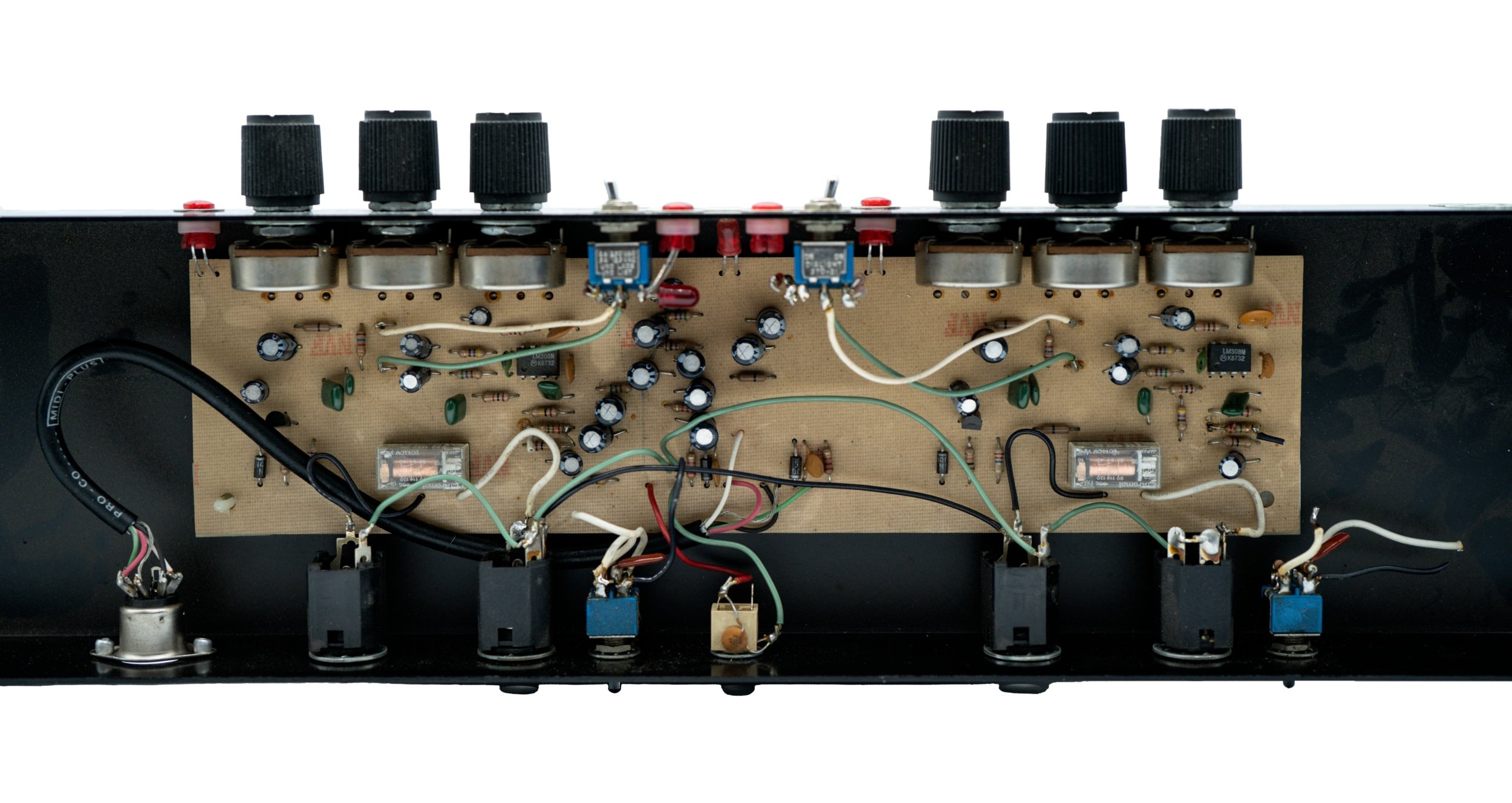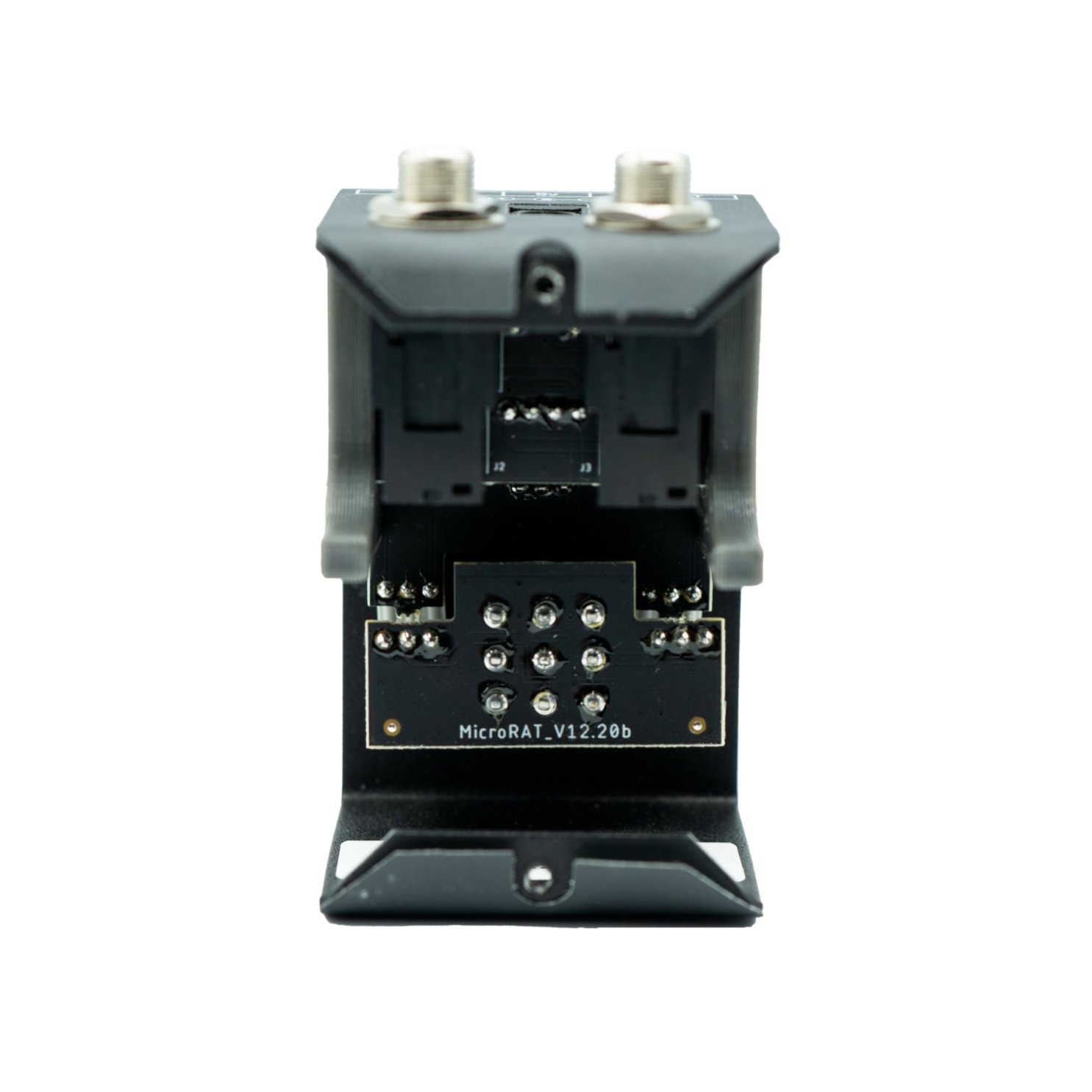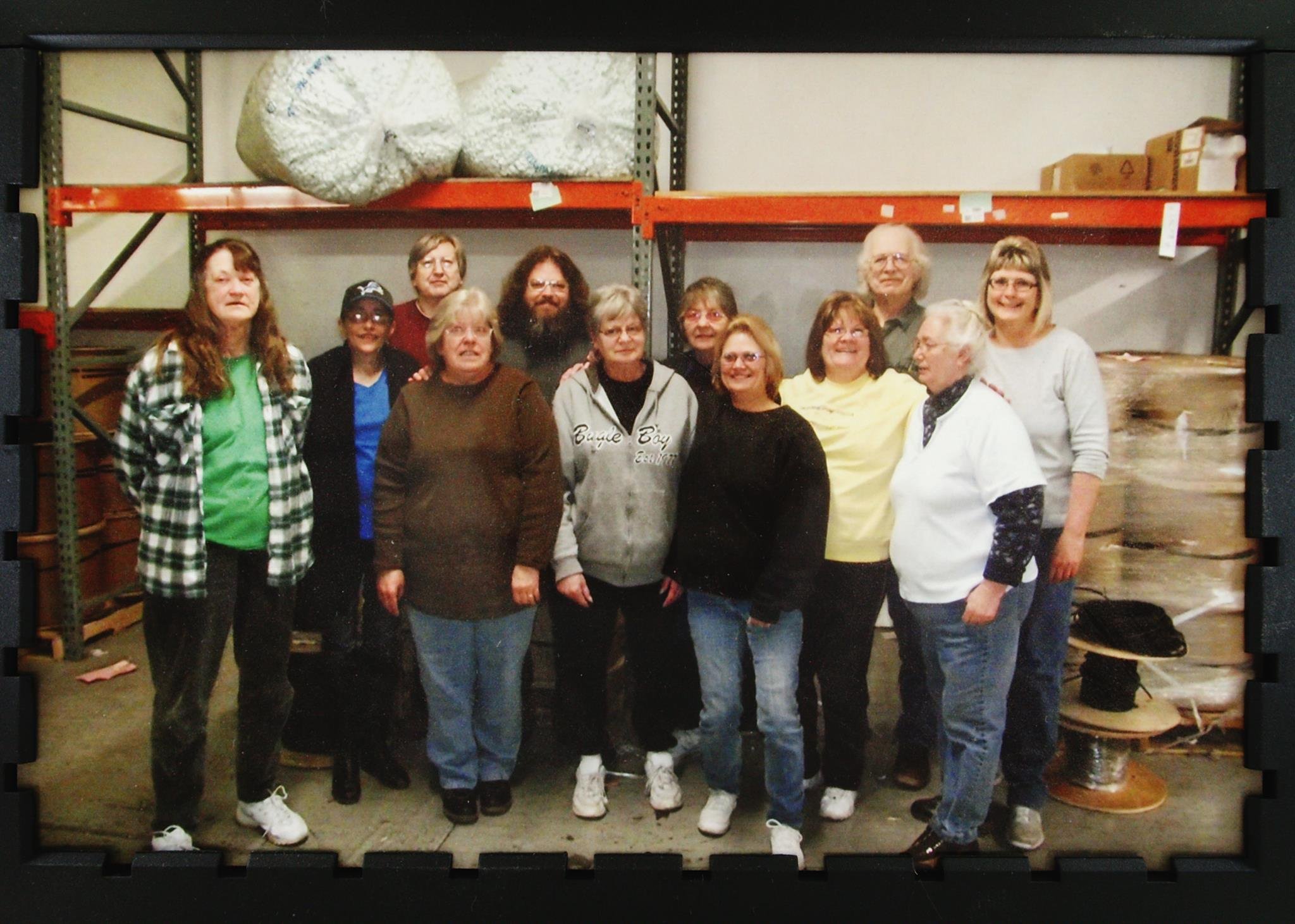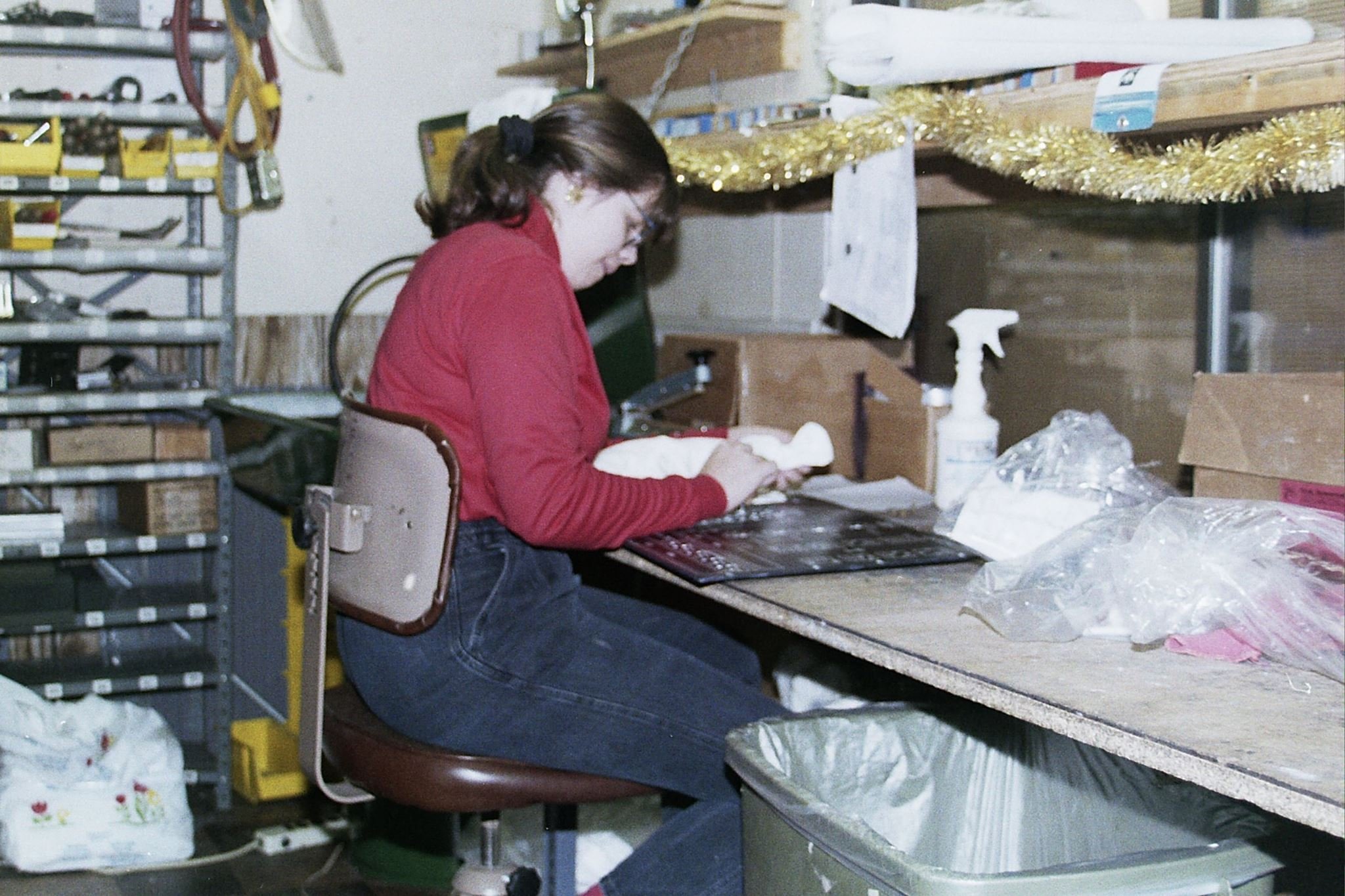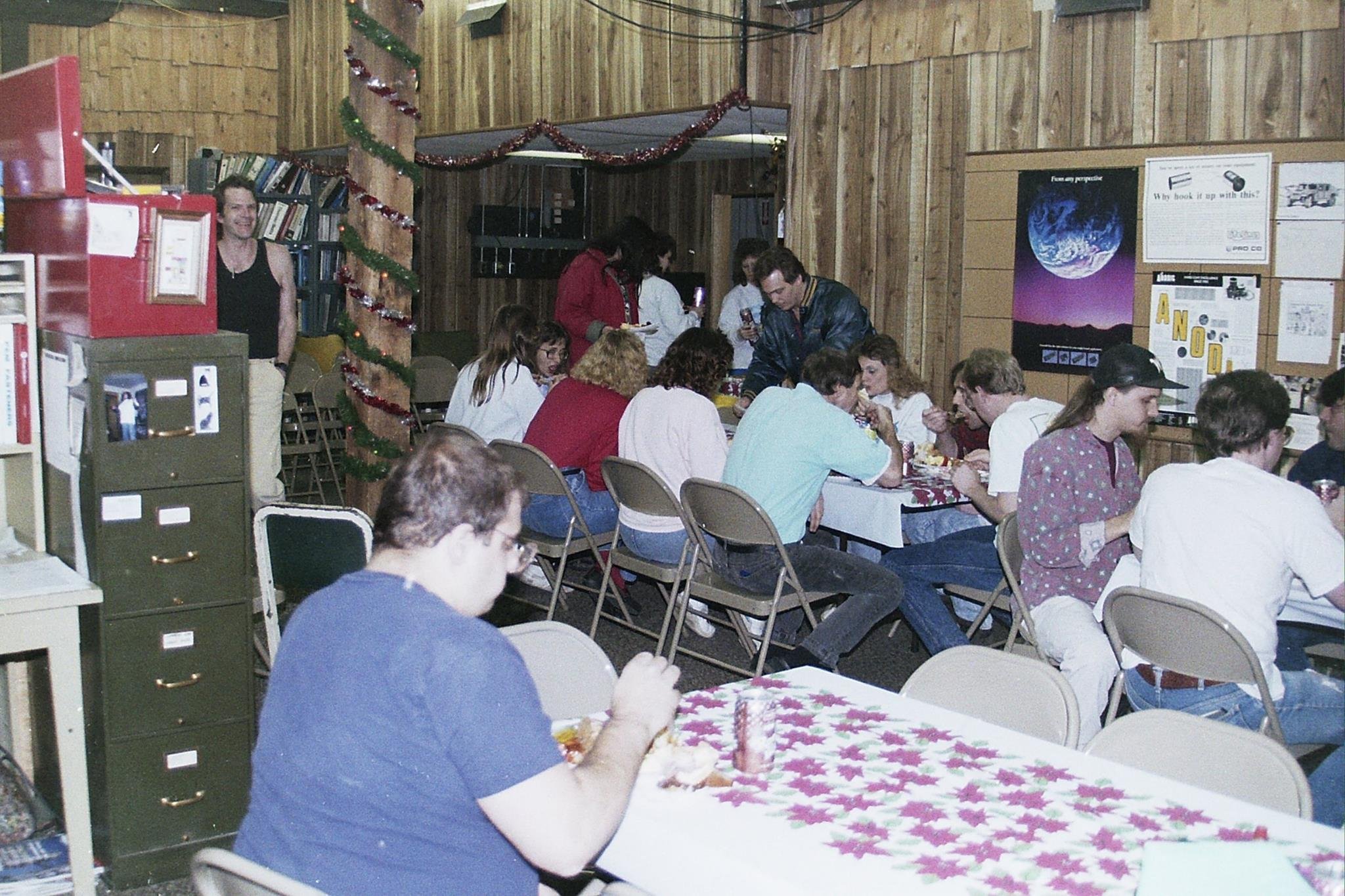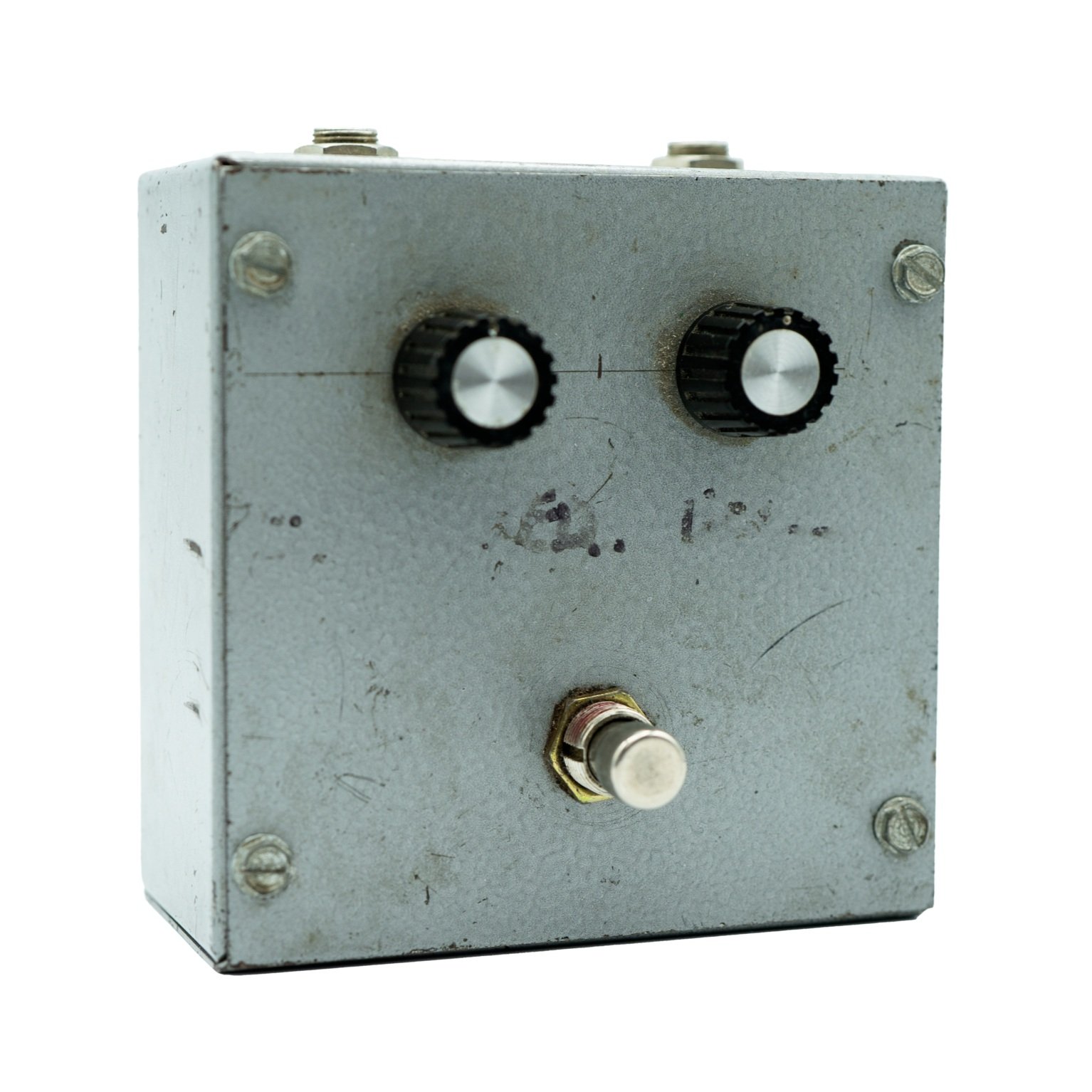ProCo RAT pedal myths, history, and timeline
This page is dedicated to the correct history and timeline of the ProCo RAT and all surrounding versions since 1977. I have spent almost a decade purposefully collecting, cross referencing and studying actual RAT units and any information below is given as a result of information I have seen and gathered personally.
Until now, I have never seen a well-done or accurate public reference on this subject of the RAT’s history, not even on ProCo’s current history page. I hope you find this information useful, entertaining and educational for your own RAT journey as a player or a collector.
HOW IT ALL STARTED
Everything started in 1974 when a Kalamazoo, MI, business called the Sound Factory (a collection of several music-related businesses) closed its doors due to hardship. The next day Charlie Wicks, who ran the music retail store portion of the Sound Factory, started ProCo Sound Inc. He began by making high quality speaker cabinets in collaboration with ElectroVoice as well as mic cables, guitar cables and stage snakes. ProCo soon gained a reputation nationally for high quality products and amazing customer service. They also rejected the typical conventions of large business aesthetic and function and stayed true to their laid back (some might say bohemian) roots.
Sound Factory Front
Sound Factory Logo
Notably, Kalamazoo is halfway between Chicago and Detroit, so big name bands that were playing in Detroit or Chicago would usually stop there between gigs. It was also a college town with a drinking age of 18 instead of 21, which resulted in an unusually lively nightlife scene. For all of these reasons, Kalamazoo already had a thriving musical scene in 1974 and was the ideal location for a musical gear company to launch.
Charlie Wicks
Scott Burnham
Sometime in 1977 or 1978 an employee/engineer at ProCo named Scott Burnham designed the RAT circuit. It is possible that the circuit itself was designed as early as 1974, thus putting it in the great hard clipping distortion genesis of that year alongside the MXR Distortion+, DOD 250, Blue Armstrong Orange Clipper and the DeArmond Square Wave.
The first known physical form of the RAT was most likely produced in 1978 and is often referred to as the Bud Box RAT.
Bud Box RAT Front
Bud Box Guts
This name comes from the pedal’s enclosure itself, which is a standard DIY Bud Industries enclosure that you could order from a catalog as a blank slate to build circuits into. The popular belief has always been that Scott handbuilt twelve Bud Boxes in 1978, but it is worth noting that Scott recently dated a Bud Box loaned to a Kalamazoo museum exhibit as made in 1977.
There has been a longstanding belief that twelve of these Bud Box RATs were made, but this is false. Scott made twelve circuits and placed them in eleven pedals, one of which was a double RAT unit made for a man named Tom Taylor. These low production numbers make the first Bud Box units some of the rarest and most collectable pedals ever made.
Double Bud Box Front
Double Bud Box Guts
Steve Kiraly (AKA Uncle Steve)
Steve Kiraly, another ProCo engineer, assisted in developing the RAT idea and design, though the exact nature of his involvement is not known. Although Steve (often referred to as Uncle Steve) was not a guitarist like Scott, he was a brilliant engineer and problem solver.
While he was developing the RAT, Burnham’s official job title was Hippie in Charge of Technology. Burnham and Kiraly had been repairing and hot-rodding existing distortion pedals for years. Burnham decided he could build a superior product from the ground up, which led to the design of the RAT. “There was always a need to get a really good, raunchy distortion sound without it being too loud,” Burnham says. “I listened to all of the distortion boxes that were out there and I didn’t like any of them, and for some reason I thought, ‘Maybe I can do something better.’” He began work on the RAT with the goal of creating “a killer distortion pedal” (by way of a hard-driving fuzz) that would capture the essence of stadium rock, but-- like almost all great rock ‘n’ roll discoveries --he stumbled into the finished product by pure accident. While tinkering on the circuit in the rodent-infested ProCo basement, Burnham attached the wrong value resistor within the circuit's op amp gain section, accidentally causing the op amp to overload and clip its rails. It was a distortion sound that he had literally never heard before. It is worth mentioning that the Bud Box circuit is basically the exact circuit we see later in the production RAT with just a couple differences like pot values, a few extra resistors and a FET input buffer.
This recently discovered ProCo product sheet shows the Bud Box RAT as an official product. This leaves some mystery to the story, as it is well known that the Bud Box was never produced in quantity. My speculation is that this was made by Scott as a way to pitch the new RAT product idea to Charlie.
Bud Box Cut Sheet
The first eleven Bud Box pedals (10 singles, 1 double) were made and sold on a custom order basis, but sometime in 1979 ProCo owner Charlie Wicks was convinced to make the RAT a full production unit in the ProCo 1979 catalog. The RAT was met with lots of internal ProCo excitement, thus they put the full-production unit in a more professional enclosure with higher quality graphic design. The graphic designer in this era of ProCo was believed to be a man named Gene Cross, so we can reasonably credit him with the look and aesthetic of the RAT.
Now, let’s examine the many versions of the RAT. Get ready, because it’s a bigger (read: zanier) story than you probably realized.
Let me preface this with a warning: popular belief on much of what you are about to read is dead wrong. The RAT, like many pedals of its age, has been subject to decades of misinformation, bad memories and keyboard vigilantes. To really understand what happened and why, you need to start over. Basically, forget everything you think you know about the RAT and embrace a new beginning. It's for the best.
My timeline and version list is based on hard factual evidence that has come from examining, cross-referencing and deconstructing hundreds of RAT pedals. If you are a long time RAT collector or fan, be prepared to have some beliefs crushed.
Due to many variations within a specific number version of the RAT, I will use a numerical/alphabetical identifying system to designate different versions. In most cases, it is impossible to simply use terms like V1 or V2, so I have expanded on that with names like V1-A (Version 1, Revision A) or V2-B (Version 2, Revision B) to more accurately differentiate between important changes in the RAT’s tangled timeline.
As many of you know, I am a student of history and welcome any and all corrections or information you can offer to this labor of love. If you have any new or additional information to share, please email me at pedalhistory@jhspedals.com.
1979 Version 1-A “Fringe Logo RAT”
Version 1-A “Fringe Logo” Front
The first production RAT pedal was released in early 1979 and is referred to as the Fringe Logo RAT. The name comes from the graphic “fringe” design that branches off from the RAT typeface. You will also notice a thick, almost cartoonish rat tail coming from the bottom of the letter R (later replaced by a sleeker, simpler tail). These units are housed in a bigger 20 gauge wrap-around enclosure, which was used in later RAT versions for several years. Coincidentally, this is why people refer to the first era of RATs as Big Box RATs.
The white RAT logo was silk-screened on black, painted metal. The EQ control of the Fringe Logo model is labeled Tone. The Tone control increased high frequencies when it was turned clockwise, the opposite of later models. More traditionally, the RAT contains three knob controls for Distortion, Filter and Volume. It uses the same fluted 1360-style knobs from the original Bud Box.
Another interesting note is that hundreds of these were labeled with left over Systech “4001” prefixed serial number labels originally printed for the Systech 4001 Flanger. Systech had previously existed in the same building but closed, leaving various parts and materials behind.
Version 1-A “Fringe Logo” Guts
Version 1-A “Fringe Logo” Back
1979 Version 1-B “Tone Control / Fluted Knob”
Version 1-B “Tone Control / Fluted Knob” Front
Sometime in mid-1979 the RAT logo design was changed. From the information I have gathered through hours of interviews with ProCo employees, this was directly from Charlie Wicks’ playbook. As a natural-born salesman with a great eye for what customers wanted, Charlie was known for changing the look of a product on the fly. There is also valid reason to believe that Scott did not like the fringe logo and found it too childish.
Whatever the actual reasons, this was simply a cosmetic change. There is absolutely no difference in the circuitry. This is a very hard-to-find version, as it has the new logo but the old Bud Box and V1-A knobs. I suspect these were only made for a few months in mid ’79 before the stock of V1-A’s knobs was eventually used up.
Version 1-B “Tone Control / Fluted Knob” Guts
Version 1-B “Tone Control / Fluted Knob” Back
1979 Version 1-C “Tone Control / Metal Knob”
1979 Version 1-C “Tone Control / Metal Knob” Front
Sometime in summer or fall of 1979 we saw another cosmetic change to the RAT. The pedal is identical inside and out to the V1-B with just one difference: instead of the fluted knobs, it has black metal/aluminum knobs. The change didn’t last long. My belief is that these knobs were ultimately too costly for the extremely thrifty Charlie Wicks, who was a master of finding ways to save money in production.
Another possibility is that the V1-C RATs were simply made using spare knobs from the Juggernaut, another RAT version that was released the same year. It is the only place we see these knobs in the RAT’s history; a fair assumption is that customers saw the Juggernaut’s knobs and liked them so much they requested them on their normal RAT. I suspect that fifty or less of these were ever produced.
1979 Version 1-C “Tone Control / Metal Knob” Guts
1979 Version 1-C “Tone Control / Metal Knob” Back
Juggernaut
Juggernaut OG Front
The 1979 - 1983 Juggernaut was a bass-specific RAT pedal with a clean blend, switchable effects loop and a master volume. It was only made for about three years as a special order product, making it very hard to find. For the sake of clarity, I will not label any specialty RAT variations like the Juggernaut, Deucetone or Vintage Reissues with a version number; I will just call them by name as they are easily identifiable from the normal RAT form factor and/or look.
The Juggernaut was officially reissued in 2003.
Juggernaut OG Guts
Juggernaut OG Back
Juggernaut Manual
Juggernaut Reissue Front
Juggernaut Reissue Guts
Juggernaut Reissue Box
1979 Version 1-D “Tone Control”
1979 Version 1-D “Tone Control” Front
In late ’79, ProCo made its last change of the decade to the RAT: they finally landed on the black, plastic knob with a white indicator line that is now considered traditional. As before, the circuit remained exactly the same as the previous 3 variations within the version 1 timeline; this change is simply cosmetic.
1979 Version 1-D “Tone Control” Guts
1979 Version 1-D “Tone Control” Back
1981 Version 2 “Filter Control”
1981 Version 2 “Filter Control” Front
By 1981, we saw the first change to the RAT’s circuit design. The change is small but notable: the Tone control label used since the first production version is changed to a Filter control label. This label reflects a modification to the circuit's low pass filter circuit. The previous V1 adds treble when the knob is turned clockwise, but this version is reversed so that as you turn clockwise the treble frequencies are filtered out of the circuit. The modification is as simple as switching two contact points on the PCB involving the Tone potentiometer. Lugs 1 and 3 are wired in reverse of the V1’s previous positions. This is the only change to the circuit, but it is a true change of the circuit and deserves to be identified as V2 of the RAT.
The effects of this change are only seen in user experience and perception, as the circuit values are identical. This perception has led many players to believe that the V2 is warmer or better in some way, but if you move the updated Filter control around a bit, you can still find the old Tone control version's exact sounds. The taper is different, but it is identical in its filtering capabilities.
It is unknown who exactly caused this change in the RAT’s design, but through interviews and an educated guess, I believe it was user feedback about how bright the RAT was perceived to be on certain amps/pickups. From that point onwards, Scott may have swapped the lugs around to reverse the perception of where the darker sounds within the circuit were coming from.
1981 Version 2 “Filter Control” Guts
1981 Version 2 “Filter Control” Back
1981 Version 2 “Filter Control” Box
1984 Version 3-A “White Face”
1984 Version 3-A “White Face” Front
In 1984 ProCo had a choice to make and they needed to make it fast. With the world's top pedal brands like BOSS, Ibanez, DOD and MXR all being produced in enclosures half the size of the RAT’s Big Box enclosure, sales began to dwindle. As a result, the RAT was nearly sent to the chopping block. In an effort to get attention back on the product and boost sales, the RAT was moved to the Small Box format. The first version of this is best known as the “White Face” RAT. The name comes from the new RAT logo that is essentially a white filled block logo with black text inside of it. This effect was achieved by screen printing white graphics on the surface of the enclosure as a logo and leaving the text un-screened to be seen as black within the white block.
1984 Version 3-A “White Face” Guts
1984 Version 3-A “White Face” Back
1984 Version 3-A “White Face” Box
White Face promotional unit
For fun, here is a picture of the actual promotional unit used in all of the 1984 ads and marketing. Bill Eaton, who still works at ProCo, preserved it in his collection.
This is, hands down, the most coveted RAT pedal on the used market. Former RAT production supervisor Kandy recalled weeks when she and the other builders would literally pull all-nighters to meet the demand for “White Face” RATs.
Technically this could be considered V2-B because the circuitry is identical to the 1981 Version 2 Filter Control. This may be the most offensive finding in my research. So many players truly believe that the “White Face'' version is different or better than other models made by ProCo, but this simply isn't true. The case is smaller and the logo is new, but the circuit remains identical to the V2 Big Box version. It is even possible to find Big Box V2’s dated 1984, as there seems to be a small window of cross production for that year. Notably, this is the last time we see the words “Sound Inc'' on a RAT pedal until the much later White Face Reissue. ProCo Sound Inc. is simply labeled ProCo after this version. I will explain why below.
1986 Version 3-B “Black Face”
1986 Version 3-B “Black Face” Front
In 1986, we saw the small box receive its first cosmetic change. The 1984 white-fill screen print logo proved to be too difficult to produce without smudges, smears and inconsistent results. A close look at most any “White Face” RAT will show you the sloppy printing results. The white ink was too dense and easily gathered in the screen producing chunky lines and gobs of white ink making the type sets and lines blurry or hard to read. As a result, the V3-B known as the “Black Face” RAT is nothing more than a logo fix-- and a very good one at that!
The white block logo is replaced with simple, thin lines that build out a very clear, easily printable graphic on the black paint of the enclosure. This new logo permanently removed Sound Inc. from the RAT’s aesthetic due to the fact that small accent text is nearly impossible to print clearly (as seen in the “White Face” version). Many of you have been told that the “Black Face” version sounds different from the earlier, more coveted “White Face,” but that is completely false. The V3-B is simply a cosmetic change due to screen printing errors.
1986 Version 3-B “Black Face” Guts
1986 Version 3-B “Black Face” Back
1986 Version 3-B “Black Face” Box
1986 Version 3-C “No Brackets”
1986 Version 3-C “No Brackets” Front
In late 1986 we had our third and final V3 iteration appear. I have to give credit to my JHS brand admin and graphic designer Katy for spotting this. I was so immersed in the minutia of the RAT’s circuitry that I never saw this slight adjustment to the RAT’s graphics. I'm giving the No Brackets V3-B its name due to the absence of any brackets or squares around the knob label names and jack label names. After research and interviews, this is a confirmed case of the constant adjustment of screen printing methods to avoid expensive printing errors. The less you print, the better success you will have printing.
As with the V3-B, this is just a cosmetic change; the circuit is the same as it has been since the V2 of 1981.
1986 Version 3-C “No Brackets” Guts
1986 Version 3-C “No Brackets” Back
1986 Version 3-C “No Brackets” Box
1988 Version 4-A “RAT2 Flat Top LED”
1988 Version 4-A “RAT2 Flat Top LED” Front
1988 Version 4-A “RAT2 Flat Top LED” Guts
1988 Version 4-A “RAT2 Flat Top LED” Back
1988 Version 4-A “RAT2 Flat Top LED” Box
By 1986, ProCo knew the RAT needed an LED status on/off indicator if it hoped to keep up with its competitors. The evidence of this is found in the prototype unit that dates 1986 throughout all of its internal components and the testimony of multiple employees. As you can see in the gut shot of the ’86 prototype, a small strip board is added into the PCB of the normal production “Black Face” RAT. This is a clever circuit addition referred to as a millenium bypass circuit (invented by longtime ProCo employee Steve Kiraly). It lets the standard 2PDT footswitch not only turn the RAT on/off, but by use of a transistor switch, it now could also turn a status LED on/off accordingly.
RAT2 Proto Front
RAT2 Proto Back
RAT2 Proto Guts
It seems that Uncle Steve designed this and, if so, he deserves major props. This update literally changed pedal history. Countless pedal makers like myself have used this same method to deal with switching problems.
Following the same pattern as previous RATs, this version features the same sound and distortion circuit as the V2 and V3. In an interview, one of the RAT2’s engineers Scott Corstange told how irritating it was when ProCo received customer comments about how different the new LED version sounded than the old Big Box versions. Corstange even cracked a joke about “how that LED turning on really changed the signal path.” The V4 RAT is one of the best examples of the way that user experience, looks and a new feature can convince guitarists that their “new” RAT sounds completely different, when in fact it's the same. While the enclosure remained the same size, the silk-screened logo gave way to a Lexan/Mylar overlay with glow-in-the-dark graphics. This is essentially a sticker that wraps the full surface area of the pedal’s enclosure, effectively ending the RAT’s long history of screen printing challenges.
Here is a photo of an unused RAT2 PCB as well as a hand drawn schematic from that year.
RAT2 PCB Solder Side
RAT2 PCB Component Side
RAT2 Schematic
Charlie Wicks’ business card
Notice Scott Burnham’s initials in the lower right corner and the dates 1974-1986 (See image above: RAT2 PCB Solder Side). This 1984 date is based on the internal narrative that Scott designed the Bud Box RAT circuit in 1974 as mentioned earlier. Also note the “Captain Of The Universe'' phrase that many of you have seen inside of RATs in different iterations. This was Charlie Wicks' moniker.
This V4 is still in production today as the flagship RAT product, but we will see a later V4-B arrive as production changes happen to this standard model.
1989 V5-A “TurboRAT”
1989 V5-A “TurboRAT” Front
1989 V5-A “TurboRAT” Guts
1989 V5-A “TurboRAT” Back
1989 brought the first major modification to the traditional RAT topology: the Turbo RAT. The boutique boom was in full swing with brands like Fulltone, Analog Man and even larger brands like BOSS demanding the market's attention. ProCo knew that they needed a new pedal to stay competitive.
Gerry Carpenter “Grape”
An employee named Gerry Carpenter (mostly referred to as Grape by employees and friends) loved building effects circuits and had stumbled across a Craig Anderton article on clipping diodes that gave him an idea. As a guitarist who plugged directly into an already distorted Marshall amp, the RAT was useless to him (it just cluttered the signal and added too much gain) so he removed the traditional silicon 1N4148 diodes from a production RAT2 and replaced them with a pair of the RED 5mm status indicator LEDs from ProCo’s inventory.
Here is the original PCB print document. Notice the previously seen “Captain Of The Universe” reference as well as a different RAT design date of 1976. This 76 date is very random and proves that even the people who create the pedals we love have a hard time keeping their stories straight.
This version change was simple but drastic, and it caused the RAT circuit to achieve sounds that had previously been impossible to achieve. Grape could now turn the volume up and the gain down low and have a very useful overdrive/boost for his setup. Charlie Wicks liked his prototype so much that the pedal was on the market within six months. Unsurprisingly, it was a hit.
TurboRAT Ad
This model is also the first to use a new sloped enclosure style where the footswitch is set lower than the control knobs. Within a few years, this would become the standard enclosure for all RAT models, giving the brand a fully competitive aesthetic compared to other major pedal brands. The RAT had now fully evolved from the primitive DIY Bud Box of 1978 to a fully sloped enclosure with mylar overlay, glow in the dark graphics and status LED indicator.
Over the years, the Turbo RAT has seen a few very minor changes in the enclosure’s steel thickness, PCB layout and the addition of glowing knob indicators, but it is still the same circuit and, except for a few small changes, it is the same aesthetic design. Because these changes are so slight and insignificant, I will move on from this version and simply refer to the newest variation as V5-B. Here is a V5-B for reference.
TurboRAT V5-B Front
TurboRAT V5-B Back
TurboRAT V5-B Guts
TurboRAT V5-B Box
A point of great interest to me is that another very popular circuit hit the market in 1989, and it shared the same hard clipping/LED arrangement of the Turbo RAT. This pedal is the English-made Marshall Guv'nor and I like to imagine that the Turbo influenced that design decision. Until these two pedals were released in the same year, this distortion technique had been absent from mainstream pedals.
1991 The Big Box Vintage Reissue
1991 The Big Box Vintage Reissue Front
1991 The Big Box Vintage Reissue Guts
By 1991, the RAT pedal reached a point of fame where people began to feel nostalgic for the original vintage model, coinciding with a big boom in the vintage instruments market. ProCo made its first reissue in company history and it proved to be a huge success, despite it essentially being the same RAT circuit that had been in production since 1981. In some ways, as successful as this reissue was, it only fed the misguided belief that vintage RAT units had some special mojo in their circuitry. Guitar players are known for listening with their eyes, and this model had a certain charm that recalled the memories of the “old RAT I shouldn't have sold” or “the RAT I could never afford back in the day”.
According to interviews with ProCo employees, this reissue was also an attempt at regaining Scott Burnham’s interest in his own pedal. He had begun to dislike the new versions of the RAT and made it clear as ProCo grew that he prefered things the old way.
The Vintage Reissue RAT can easily be identified from the original in two ways. First, the ProCo logo does not contain the “Sound Inc” screen print portion. The reissue also features an easy access battery compartment on the pedal’s bottom. This version was made from 1991 through 2005.
1997 V6-A “Roadkill”
1997 V6-A “Roadkill” Front
1997 V6-A “Roadkill” Guts
In 1996, Guitar Center approached Charlie Wicks with the request for an exclusive RAT version to sell in their stores and through their Musician’s Friend catalog. This request came with one major caveat: it needed to cost GC a total of $15 at cost so that they could sell at a very competitive price.
The engineering task was assigned to Grape, the man who had designed the Turbo RAT in 1989. The task of a USA-made, $15 pedal certainly had challenges, mainly off-setting the price of the original steel enclosure. Grape rigged a new and more affordable enclosure with PVC pipe from the hardware store, which incorporated metal sides to support the pedal and give stability while the rest of the enclosure was made from hard ABS plastic. The assembly was simple and quick by allowing the circuit to pop into the face plate, then fastening the sides and back with screws.
The circuit was where Grape really shined as an engineer. It is the most drastic variation from the standard RAT topology to date, featuring an input buffer, soft clipping inside the op amp’s feedback loop (like a Tube Screamer), capacitor changes for frequency adjustments, soft touch on/off, as well as the traditional RAT hard clipping. This RAT features a departure from the classic control names and goes after the insanely popular DOD “Jason Lamb Era” aesthetic of the time. The controls are Headlights, Screech and Splatter and the footswitch is surrounded by a blood splatter graphic. This is the nineties grunge aesthetic at its finest.
Roadkill Box
Roadkill Box
Roadkill Box
Roadkill Box
Even though the Roadkill is an extremely versatile pedal, it never got the respect that it deserved due to its budget price and plastic enclosure. This pedal along with the V6-B were produced until roughly 2001.
1997 V6-B “BRAT
1997 V6-B “BRAT Front
Charlie Wicks was a very determined businessman who chased opportunity. When Guitar Center signed the deal on the exclusive Roadkill pedal, Charlie prepared aggressively by ordering lots of PCBs and enclosures but the demand was not as high as he had expected. Charlie immediately pivoted by creating a secondary product from the same exact materials. The result was the BRAT pedal. Effectively this model is a Roadkill with different hot pink branding and alternate control labels. I like to think that BRAT stands for “Budget- RAT” but that's probably just wishful thinking.
1997 V6-B “BRAT Guts
1997 V6-B “BRAT Box
2002 “Deucetone”
2002 “Deucetone” Front
2002 “Deucetone” Guts
2002 “Deucetone” Back
2002 “Deucetone” Box
R2DU Ad
The Deucetone has its origins in a dual RAT rack mounted unit from the ’80s called the R2DU. To understand the Deucetone and appreciate it as a product, I think it's worth a moment to break down the R2DU as its origin.
The original R2DU was two RAT PCBs placed into a 19” rack unit and a remote footswitch to activate the on/off of each circuit. Popular belief is that the R2DU was produced between 1984 and 1988, but I have several reservations about that. My first reservation is that I cannot find any release literature or documentation with dates before this 1988 advertisement. Secondly, the name itself stands for RAT2 Dual Unit. The RAT2 was released in 1988, the exact year of that first available 1988 R2DU advertisement. There is a chance that these were custom order units during the “White Face” and “Black Face” era of 1984-1988, but I cannot find any actual evidence of this. Thirdly, in an interview with Scott Corstange (who started with ProCo in 1986), he says that he remembers seeing the first examples of this idea around the time that they started development of the RAT2 in 1987. My belief is that it was released with the RAT2 as a commercial production unit in 1988 and that it was met with low interest and quickly discontinued. Lastly, this “Rack RAT” layout signed and dated by Grape in November of 87 once again places actual mechanical and design work well outside of 1984. Though the exact details are hard to pin down, I see no evidence of an early or mid ’80s release.
Rack Rat Component Layout
Fast forward to 2001 and Charlie Wicks has the idea to reissue the R2DU with the hope of channeling some of the vintage nostalgia that made the Vintage Reissue RAT so successful. His idea was met with instant disagreement from ProCo employees, as no one liked building the rack unit and it never sold well when it was in production. Grape suggested that he make a dual RAT pedal version in the spirit of the R2DU, because it was the 2000s and rack units were not in vogue. He took the RFST footswitch from the R2DU and inserted two 2001 RAT2’s inside, wrapped it in two RAT2 mylar stickers and presented it as the official prototype. Charlie liked it and the rest is history.
R2DU RFST Footswitch
DeuceRAT Prototype Front
DeuceRAT Prototype Guts
The Deucetone was officially released in 2002 and is still being made today. It features two independant or stackable RAT circuits, each with three selectable clipping circuits. Channel A has the Turbo RAT mode (LEDs), Vintage mode (1n4148’s) and a new mode called “Dirty RAT”. This last mode will make a full appearance later in a new version. Channel B has Turbo RAT mode (LEDs), Vintage mode (1n4148’s) and a Clean mode. The Deucetone is extremely versatile and was in many ways holding two new RAT variations within it, but only one of these would get past the prototype phase and into production.
Another puzzling issue of this narrative is an R2DU that I own that has been modified with the Deucetone’s exact toggle switch clipping options. It dates from 1988 and it is my belief that this unit was a stock R2DU found lying around the shop that Grape used to work out the ideas before he applied them into the dual pedal enclosure.
R2DU
R2DU Guts
R2DU Clipping Toggle Modifications
A fellow RAT collector Dana Osmond has R2DUs that have aesthetics that conflict with the dating internally. One has a hand-cut backlit sticker logo with LED indicator inside the “A” of RAT in the fashion of a RAT2 pedal and dates from 1988. That seemingly checks out with my timeline and assumptions on the release date. But another unit has no LED, the simple screen print aesthetic of a “No Brackets” RAT circa 1986-1988 and dates internally to 1991.
This is proof that ProCo had no rhyme or reason. As far as the R2DU timeline is concerned, your guess is as good as mine.
2008 Version 4-B “RAT2 Chinese Made Slope enclosure”
2008 Version 4-B “RAT2 Chinese Made Slope Enclosure” Front
2008 Version 4-B “RAT2 Chinese Made Slope Enclosure” Guts
2008 Version 4-B “RAT2 Chinese Made Slope Enclosure” Back
2008 Version 4-B “RAT2 Chinese Made Slope Enclosure” Box
The RAT2 that started its production in 1988 continued with great success to the point that between 2003 and 2005, ProCo had trouble meeting the demand of production alongside all of its other products. Charlie Wicks found himself in a conversation with one of ProCo’s largest parts suppliers Neutrik (who supplied the company with cables, jacks and cable ends) about this issue and struck a deal with Neutrik to build the RAT2 offshore in its Chinese factory. At this transition, ProCo converted the RAT2 to the Turbo style sloped enclosure and the production of all RAT2s has stayed this way to this day. Despite the occasional forum professionals' thoughts on this change, the RAT2 V4-B is a well built and excellent sounding pedal that you would be hard pressed to pick out from a lineup with any vintage RAT ever produced.
There have been a few PCB variations to the internal layout of the V4-B RAT, but the circuit has stayed the same. Many people often refer to different versions within this Chinese production but I don't believe that it’s necessary to differentiate them. The only change worth mentioning is that ProCo started phasing out the long established LM308 op-amp in 1995, meaning that any RAT2 made after 1996 (developed by Gerry “Grape” Carpenter) contains the replacement OD07DP op amp . According to Bill Eaton, the LM308 was declared obsolete by Texas Instruments in 1993. They instructed the licensed manufacturers, National Semiconductor and Motorola, to stop manufacturing them. Said Eaton, “Our distributors told us these would disappear quickly. Grape worked on the substitution process and came up with the OP07DP. As we both know, these were in the surplus world for many years. Most were auto insertion rejects, from what I understand.”
I will save my heartfelt rant on the erroneous myth concerning how the LM308 is an irreplaceable and magical part that any “real” RAT must contain (you can find it in the RAT Myths section).
One last note from me on this V4-B is that they are made well but the potentiometers are prone to breakage. This shouldn’t be an issue for the typical player, but when you attempt repairs or modifications, it almost always ends in replacing all three pots. For this reason, many people simply stopped modding the RATs from this era.
There are three more variations within this version that are especially important to collectors. These are the IKEBE 40th Anniversary special color editions. IKEBE has been the biggest dealer of RAT pedals worldwide since the late 1980s and it is because of them that ProCo considered such ventures as the Turbo and other variations. These special colorways were commissioned in 2015 as Japan only editions and currently include White (V4-C), Red (V4-D) and Yellow (V4-E). These are simply aesthetic changes and contain the same exact circuit board as any standard black RAT available today.
Version 4-C “RAT2 Chinese Made Slope Enclosure” White Front
Version 4-D “RAT2 Chinese Made Slope Enclosure” Red Front
Version 4-E “RAT2 Chinese Made Slope Enclosure” Yellow Front
It is worth mentioning that although this model was outsourced to China, all the other RAT models continued to be made in the USA.
2003 “25th Silver Anniversary Edition”
2003 “25th Silver Anniversary Edition” Front
2003 “25th Silver Anniversary Edition” Guts
2003 “25th Silver Anniversary Edition” Back
Dana Osmun and Charlie Wicks
The story goes that one day Charlie Wicks walked into the shop and said, “Let's make a silver anniversary RAT. We will give them to all the high profile players and friends who have helped us over the years.” And, basically, that's what happened. ProCo worked up a stainless steel silver version of the 1991 Vintage Reissue enclosure, a new screen print graphic that included the phrase “25 years of grunge”, used some unused 1991 Vintage Reissue PCBs that were laying around and made between 25 and 50 units (accounts vary). RAT collector Dana Osmun said he stopped by ProCo one day and Charlie handed him one.
Charlie Wicks literally made the Anniversary Edition RAT so he could give it away. Profit was not the goal. Honor was. This unique pedal was-- and still is --a true celebration of everything the RAT has done for ProCo.
2004 V7 “You Dirty RAT”
2004 V7 “You Dirty RAT” Front
2004 V7 “You Dirty RAT” Guts
2004 V7 “You Dirty RAT” Back
2004 V7 “You Dirty RAT” Box
The origin of the You Dirty RAT starts at Grape’s workbench, this time around 2001. Having designed the Turbo in 1989, he had proven that changing the clipping diodes would make huge changes in the RAT’s distortion tone and characteristics. As he worked through more modifications for the Deucetone idea, we saw even more experiments in changing the diodes within the RAT’s circuit. The You Dirty RAT is the Deucetone’s “Dirty RAT” position placed in a singular, self-branded enclosure. This model was the result of players requesting this mode as a stand alone unit outside the Deucetone. This mode replaces the traditional 1N4148 clipping diodes with germanium 1n34A clipping diodes. While the Turbo modifications give you more headroom, better cleans and a more open sound compared to the traditional RAT diodes, the 1n34As achieve the complete opposite. The sound is much more saturated and compressed. This version was released in 2004 and is still available today. The only change in this circuit's timeline is that the germanium 1n34As were replaced at some point recently with Schottky BAT-41 diodes due to the scarcity of the germanium parts. This has no effect on the tone of the pedal as these parts are virtually identical in specification.
Newer Glow in the Dark Pointer Front
Newer Glow in the Dark Pointer Back
You Dirty Rat “Typeface Logo” Prototype/Test Print
As always, there’s still a puzzle to this RAT variation. I acquired what seems to be a prototype or first article of production for the You Dirty RAT. It does not share the established “furry rat” style lettering but instead has a very simple Helvetica-esque typeface. However, the box and packaging that is serial number matched to the unit does have the standard branding and logo. After showing this unit to various ProCo employees and engineers, I still don’t know why or how this unit was produced. The only reasonable conclusion is that this one-off pedal was sent to a European dealer as a sample in the early pre-release stages of the You Dirty Rat’s debut.
2006 V8 “Solo” RAT
2006 V8 “Solo” RAT Front
2006 V8 “Solo” RAT Guts
2006 V8 “Solo” RAT Back
2006 V8 “Solo” RAT Box
The Solo RAT was born under the familiar pressure to produce a new RAT product for the pedal market. Once again, Grape was tasked with the engineering duties and, as usual, he delivered. The Solo RAT is a fantastic alternate take on the RAT featuring several component changes, a three way clipping switch that offered several unique configurations of diodes and most notably the addition of a baxandall style bass and treble control labeled Scoop and Tone. This is the first RAT variation ever produced with four controls.
I have what I believe to be the only prototype unit and it shows a nice perspective into Grape’s methodology. It is in an early 2000s sloped enclosure with the traditional three pot drill layout. To utilize this enclosure and still achieve the four pots needed for his idea, he used a Stew Mac dual concentric potentiometer that was manufactured to be used in a guitar. It also shows a fully designed alternate name and branding as the RAT-Zo. One employee shared with me that they felt the RAT-Zo name would have been much more fitting, as the name SOLO does a disservice to the versatility and quality of the circuit. This pedal shines on big chords, huge riffs and plenty of areas other than guitar solos. Ultimately, it stands as a good example of a branding faux pas.
RAT-ZO Prototype Front
RAT-ZO Prototype Guts
Interestingly, there is one more Grape variation of the RAT that never made it past the prototype phase. The unit is simply labeled the “ProCo Preamp Prototype'' and is made from an older RAT2 enclosure that has had the mylar sticker wrap removed and white tape with Grape’s handwriting for labels. This is the other Deucetone mode known as “Clean RAT”. It effectively removes the clipping diodes altogether and creates a loud and extremely powerful clean boost. If you try to push the saturation control into distortion at all, the op amp itself is completely overloaded and this creates a very harsh but usable distortion tone. It is a fun addition to the timeline and a great example of what could have been.
ProCo Preamp Prototype Front
ProCo Preamp Prototype Guts
2010 “1985 White Face Reissue”
2010 “1985 White Face Reissue” Front
2010 “1985 White Face Reissue” Guts
2010 “1985 White Face Reissue” Back
2010 “1985 White Face Reissue” Box
In 2010, the same year that founder and owner Charlie Wicks passed away, ProCo released a special limited edition reissue of the 1985 White Face V3-A. It is a very rare collector’s piece and is an exact replication down to the use of NOS original LM308 op amps. The logo print is slightly smaller when compared to the original, which helps us differentiate between real vintage units and the reissues. These were only made during 2010 and helped spur the idea of the 2014 FATRAT.
2014 V9 “FATRAT”
2014 V9 “FATRAT” Front
2014 V9 “FATRAT” Guts
2014 V9 “FATRAT” Back
2014 V9 “FATRAT” Box
The FATRAT is an excellent attempt at capturing the popular modifications that builders had been performing to the RAT circuit for decades. An added bass enhancement circuit, switchable clipping section (including a never before used MOSFET arrangement), and other modifications make the FATRAT a RAT lover's dream. It is the most versatile RAT ever produced by ProCo. The basis for this model was built on the work done for the 2010 “White Face” reissue and a new larger enclosure was produced that sets the FATRAT apart from any other RAT version. If you are new to the RAT circuit, this is a great starter pedal, as it captures so many of the different tones and flavors of the classic circuit.
The original prototype unit is built into an unprinted 25th Anniversary enclosure and labeled “RAT Bastard''. This model had several people at the helm including Bill Eaton, Chris Frankhauser and Bill Hanepel. From my understanding, this was a team effort, and the result is fantastic.
RAT Bastard Prototype Front
RAT Bastard Prototype Guts
2021 V10 “Lil’ RAT”
2021 V10 “Lil’ RAT” Front
2021 V10 “Lil’ RAT” Guts
This is the latest evolution of the RAT that ended a seven year drought of new RAT innovation. Using surface-mount technology, the Lil’ RAT faithfully and accurately gives you the exact RAT2 circuit in a 2” enclosure. It doesn't have a battery compartment, but it sounds exactly the same as its RAT predecessors. A side by side comparison of the Lil’ RAT with a vintage RAT2 proves that people who still believe surface-mount components can’t sound like through-hole components are painfully wrong in their assumptions.
The Lil’ RAT sounds identical and has a quieter noise floor. It is an excellent pedal for those who love the RAT tone but don’t have space on their pedalboard for a larger enclosure.
More than anything, the RAT is a great pedal because of its origin, not just in a rat-infested basement but at a family-oriented company in Kalamazoo founded on mutual respect between a founder and his employees. Although Charlie Wicks passed away in 2010 and ProCo was purchased by RapCo soon afterwards, former employees still fondly remember the years they spent building RATs at this endearingly offbeat workplace. It was the kind of laid-back work environment that shouldn’t have worked on paper (how could RAT builders simultaneously have that much fun on the job and be so efficient?), but it did. Every now and then, you’ll see a company that manages to harness the same kind of manic energy, but I’d argue that the unique atmosphere at ProCo Sound Inc-- more specifically, in the “RAT’s nest” --may never be equalled. Maybe that’s as it should be.
Here are some of my favorite selected photos provided by employees that show what a family this company truly was. Let these be a reminder of what I have said for years on the show: “Companies don't make things, people do.” Long live ProCo!
I want to close this section off with a huge thanks to my new friend Dana Osmun who graciously let me use part of his RAT collection for my final studies and reference to complete this article. It was an incredible experience to have four of the original Bud Box circuits in one room; we could have taken over the world with that much power, but I don’t think either of us had goals that were quite that lofty.
Josh Scott and Dana Osmun with Two Bud Box RAT Pedals
I would like to also thank former ProCo employees Bill Eaton, Chris Frankhauser and Scott Corstange who also allowed me to access several prototype units that they’d held onto over the years.
BUSTING MYTHS:
“The early versions with tantalum capacitors sound way better.”
This myth is a classic case of a guitarist needing something to explain an idea. Early RAT models used a certain type of capacitor known as a tantalum capacitor and were replaced eventually with normal electrolytic capacitors. The idea that these tantalum caps sound better is completely illogical and false. The up-to-20% parts tolerance from pot manufacturing is a much bigger factor in perceived tone change across various units than anything this minor component change could have caused.
A tantalum cap from a V1 Fringe RAT. Despite Scott Burnham stating that these have no auditory difference from the later used electrolytics, guitarists just want to believe in magic. He said he only used them because he thought it was cool that NASA had them in their equipment.
“A real RAT has an LM308 op amp; nothing else has the right sound.”
This myth is one of the most frustrating as a pedal designer and as someone who has studied the circuit in great depth. The RAT circuit is effectively a simple op amp boost that sends its amplified signal across diodes that shunt to ground. This creates the sound known as hard clipping. One of the many unique things that the RAT has going for it is that the op amp is actually run at such a high rate of gain that it distorts before the hard clipping distortion is ever started. This gives a rich distortion tone that has lots of complex harmonics. This approach to design is actually due to a mistake that Scott Burnham made by accidentally placing a 47 ohm resistor where a 470ohm resistor should have gone.
This small but wonderful mistake led to the RAT’s trademark sound. In the original units, a LM308 op-amp was used and many people use its existence much like the tantalum cap as a sort of physical explanation for the really great RAT sound they remember. This op amp was discontinued in the early 2000s, phased out of the RAT’s production around 2005 and was replaced with the OP07. Despite popular opinion and rumor, this OP07 is a perfect replacement for the LM308. Its response, slew rate and frequency attenuation are identical. Sadly, the arguments you see for this rumor are never scientific or controlled, they are based on memory or a simple ear test that compares two RATS. This is impossible to test accurately, as you need to use the EXACT same circuit and you need to perfectly switch between two op amps instantly. It’s been scientifically proven that just a few seconds between audio perception is impossible to hear, let alone compare.
OP07
LM308
Here are both op amps compared. If you only see one line, that’s because they overlap perfectly. They are identical in performance and sound.
These show the response and operation of the two rivaled op amps in three different settings. Do you see both lines? The OP07 is blue and the LM308 is red. I think you get the point.
The other issue with this is that no two RATS sound exactly the same. To take that further, no two pedals of any make or model sound exactly the same with knobs at the same spot. You can pull any two RAT pedals of any era together with consecutive serial numbers, made on the same day by the same builder, and they will still sound slightly different with the knobs at the same positions. This is mainly due to parts tolerance and the fact that no two pedals’ components will match exactly, ever. (They usually have a deviation of somewhere between 5-20% depending on the components.) What this doesn't mean is that they can’t sound the same. You simply turn the controls a tad and you can find the exact same sounds in both. Pedal shootouts are a ton of fun (I’ve performed a few myself), but at the end of the day they are a woefully inaccurate approach to comparison and should not be considered a serious method of scientific analysis.
My last and final observation about this myth is that claiming the LM308 is the sound of the RAT is a serious disservice to Scott Burnham’s amazing design and it invalidates the quality and approach to his idea. The RAT doesn't sound great because of the LM308; rather, the LM308 sounds great because Scott’s circuit used it well and it continues to use the exact replacement part OP07 in the same way. If you think a vintage RAT sounds better because of the chip, bear in mind that there are far bigger tolerances in play-- and the chip isn’t one of them.
One last thing: even if you do find an old stock LM308 op amp in 2021, there is a VERY high chance that it is a counterfeit. I have studied several batches of supposed NOS LM308’s in my research, and this is a big problem on the parts market. We really should let this myth go because there are still pedal builders today that are selling RAT style pedals on the backs of them having this “magic” component while in reality, they’re probably just relabeled.
“You need to get a Woodcutter RAT, they sound way better.”
There have been rumors flying around forums for decades about a legendary builder known only as Woodcutter. Allegedly, Woodcutter worked at ProCo in the late ’80’s and ’90’s and built the best RAT pedals of all time. But did he?
Here are the facts: yes, there were multiple builders working at ProCo when the RAT was originally released and yes, Doug Fetterolf (AKA Woodcutter) was one of them.
Doug Fetterolf (AKA Woodcutter)
Every builder had a quality control sticker with a name that attached the pedal back to the builder in the event that the pedal didn't pass testing. Doug built pedals as a part time job; he was a school teacher, with a side hustle of cutting down trees and splitting logs. You know, working as an actual woodcutter. The main reason that Doug ended up with the Woodcutter nickname is because there were multiple guys named Doug working at ProCo at this time. It wasn’t meant to be mysterious or cool; it was just a way of telling the Dougs apart.
We find Woodcutter Doug’s stamp on a ton of vintage RAT pedals, but are they magical? More importantly, are the Woodcutter RAT pedals significantly better than any of the others ProCo produced around this time?
Nope.
From the sheer number of pedals that exist with the Woodcutter sticker/stamp, we can confirm that Woodcutter was a fast builder. Very fast. Kandy, the RAT production supervisor, says that he was the best builder they ever had. Gerry “Grape” Carpenter said that Doug “probably stuffed more RATs than anybody else there, because that's all he liked to do.” From a production standpoint, he was amazing. He built more RATS than any other builder in his era and did it while only working part time.
Here is Doug at the RAT assembly station with his co-workers. The first picture shows Doug on the right in a blue trucker hat. This picture reveals how all the builders used the same parts, the same tools and followed the same rules. The second picture shows Doug’s back as he builds, Kandy (the RAT production supervisor) and Doug's wife Tish boxing 1991 Vintage Reissues.
But the facts are: 1.) Doug wasn't a guitarist, 2.) He didn't understand circuitry, and 3.) He built his RATs from a parts kit just like every other builder on the line. The idea that his pedals have a secret mojo is absolutely absurd and 100% false. Woodcutter was no more of a circuit designer or modifier than sewing on the back pockets of a pair of Levi’s would make someone a fashion designer. He followed the rules.I’m guessing some guitarist saw this stamp on their pedal, loved the sound and made the totally unverifiable claim that their RAT sounded better than the others because Woodcutter built it. And the rest is history.
OTHER PROTOTYPES:
These are a few notable pieces of ProCo history that I am still learning about.
First up is a Bud Box era pedal that Scott Burnham built. He has said that it was basically a Craig Anderton schematic with a few tweaks and mods. It is a ring modulator and includes many of the same parts that are dated alongside the original Bud Box circuits. The gray primer style paint is visible inside both Bud Boxes I have seen, which means that this was made alongside those units, or is at least very near them in date.
Next is a similar era pedal possibly built by Burnham but in a much larger Bud Box enclosure. It is an envelope controlled filter with an attached AC power cable with Bud Box knobs. This pedal brings up more questions than I can answer at this point, but it could have its origins from Systech rather than Proco. I'm unsure. The factor that ties it to Burnham for me is the use of the Bud Knobs, Bud Box case and the wiring.
One day I will figure it out.
The last mystery prototype in the collection is a 1988 RAT2 that was obviously used as a sacrificial prototype like we have seen in so much of ProCo’s R&D methodology. Inside is a second (stacked) PCB with seven transistors and loads of other parts. A piece of cardboard is shoved in between the boards and duck taped. It also has a different footswitch. I want to connect this to the Roadkill, and I'm 99% sure it is related somehow.
This strange specimen comes from Ed Lehane a touring and session guitarist who contacted me after this article was written. It is a Stereo RAT that falls into the dual RAT category but is very unique. It contains two stock RAT reissue circuits built on the 1991 PCBs and is wired so that the footswitch activates both circuits separately through separate in/out jacks but at once. The idea is that you can have two RATS set independently for two different amps at once. The pots all date 1995 and according to interviews, this was an experiment / custom build that year. Two of them exist at most.
Andy Summers (The Police)
Dave Grohl (Foo Fighters)
David Gilmour (Pink Floyd)
Derek Whibley (Sum 41)
Frank Black (Pixies)
Graham Coxon (Blur)
James Hetfield, Kirk Hammett (Metallica): Used in Metallica’s debut album “Kill ‘Em All.”
Jeff Beck (The Yardbirds): The secret behind his huge yet incredibly subtle tone is not due to some elaborate rig. No – Jeff just uses a ProCo RAT pedal. “The biggest thrill was in 1985, when I saw a picture of Jeff Beck using my pedal,” Scott Burnham says.
Joe Perry (Aerosmith)
Joe Walsh (Eagles)
John Scofield
Johnny Buckland (Coldplay)
Johnny Greenwood, Thom Yorke (Radiohead)
Justin Lockey (Editors)
Kim Gordon (Sonic Youth)
Krist Novoselic, Kurt Cobain (Nirvana)
Mark Gardener (Ride)
Neil Halstead (Slowdive)
Nels Cline (Wilco)
Nuno Bettencourt (Extreme): Says Nuno: “[I] can’t go without a Rat when playing through any of [my] Marshall amps.”
Peter Buck (REM): used on R.E.M.’s entire “Monster” album.
Peter Holmstrom (Dandy Warhols)
Rivers Cuomo (Weezer)
Robert Fripp (King Crimson)
Russell Lissack (Bloc Party)
Thurston Moore (Sonic Youth)
Tom Linton (Jimmy Eat World)
And a million more. The RAT is one of the most beloved pedals ever created.
Works Cited / Sources
Australian Guitar. (2021, January 4). PROCO RAT. Retrieved October 15, 2021, from https://pressreader.com/article/282802128949621
ElectroSmash. (n.d.) Pro Co Rat Analysis. Electrosmash.com. Retrieved October 15, 2021, from https://www.electrosmash.com/proco-rat
Kennedy, P. (2012, November 30). Who Made That Rat Distortion Pedal? The New York Times. https://www.nytimes.com/2012/12/02/magazine/who-made-that-rat-distortion-pedal.html
Marshall, M. (2021, January 28). The Rat. Anatomy of Guitar Tone. Retrieved October 15, 2021, from https://www.anatomyofguitartone.com/home/2019/1/30/the-rat
ProCo Sound. (2021). About Us. Ratdistortion.com. Retrieved October 15, 2021, from https://www.RATdistortion.com/topic/about
Rayes, A. (2017, September 1). Little Black Box. Encore. Retrieved October 15, 2021, from https://www.encorekalamazoo.com/little-black-box
Scott, J. (2021). Personal interviews with past ProCo employees.
Slavković, D. (2020, October 1). BRIEF HISTORY OF PRO CO RAT. Samash.com. Retrieved October 15, 2021, from https://www.samash.com/spotlight/brief-history-of-pro-co-RAT/
Thompson, A. (1997). Stompbox: A History of Guitar Fuzzes, Flangers, Phasers, Echoes & Wahs. (pg. 120-127). Miller Freeman Books.
Total Guitar. (2014, June 9). Pro Co RAT. Total Guitar Magazine. Retrieved October 15, 2021, from https://pressreader.com/article/283729837331343
Total Guitar. (2019, April 12). Proco Rat. Total Guitar Magazine. Retrieved October 15, 2021, from https://pressreader.com/article/282003263795561
West Mich Music Hysterical Society Editors. (2021). Pro-Co Sound. West Mich Music Hysterical Society. Retrieved October 15, 2021, from http://www.westmichmusichystericalsociety.com/pro-co-sound/
Wikipedia Editors. (2021). Pro Co RAT. Wikipedia.com. Retrieved October 15, 2021, from https://en.wikipedia.org/wiki/Pro_Co_RAT
Youtube Music Sucks. (2020, May 10). Famous Users of Pro Co Rat Distortion Pedal. YouTubeMusicSucks.com. Retrieved October 15, 2021, from https://youtubemusicsucks.com/famous-users-pro-co-rat-distortion-pedal/




